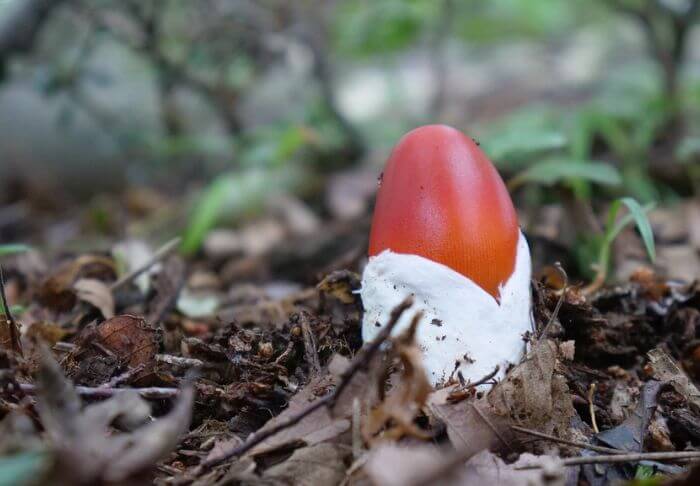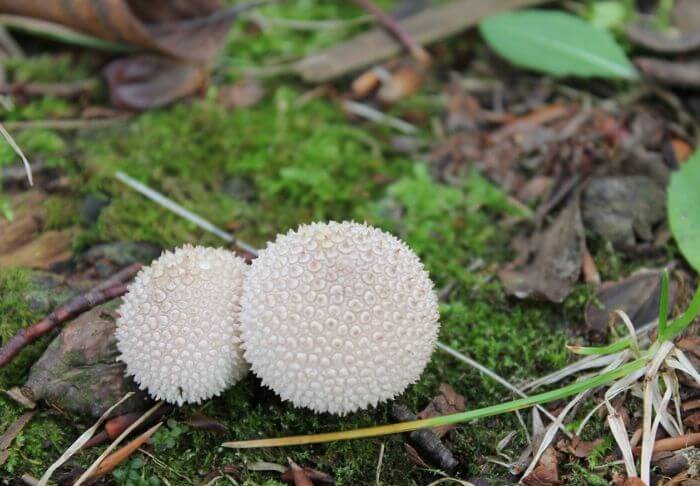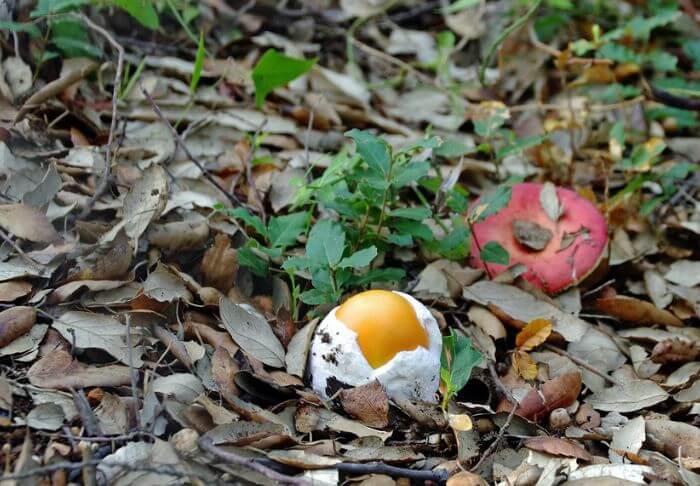As we delve into the world of mycology, it becomes apparent that nature’s creativity knows no bounds. There is an intriguing group of fungi that encompasses various species that share the common characteristic of resembling bird eggs in their shape, size, and coloration.
Ranging from delicate creamy orbs to robust oval structures, these remarkable mushrooms have inspired awe and curiosity due to their striking similarity to one of nature’s most universal symbols: the egg.
Whether you’re a seasoned mushroom hunter or simply captivated by the mysteries of the natural world, exploring the realm of egg-like mushrooms promises an adventure rich in both visual marvels and scientific intrigue.
List of mushrooms that look like eggs
1. Caesar’s Mushroom

The Caesar Amanita, also known as Amanita caesarea, is a strikingly beautiful and enigmatic mushroom that boasts a vibrant orange cap and white gills.
Found in the Mediterranean region and parts of North Africa, this prized edible mushroom has been revered for its delicious taste and cultural significance.
Its regal appearance and egg-like shape make it a captivating addition to any forest landscape, often catching the eye of foragers and fungi enthusiasts alike.
This esteemed mushroom was favored by Roman emperors, leading to its common moniker Caesar Amanita.
Its association with royalty lends an air of mystique to the already intriguing fungus. However, despite its culinary appeal and historical allure, the Caesar Amanita harbors a toxic look-alike in the form of the deadly Amanita phalloides.
This doppelgänger adds an element of danger to the pursuit of finding these egg-shaped mushrooms in their natural habitat.
2. Common Puffball

The common puffball, also known as the Lycoperdon perlatum, is a fascinating mushroom that resembles a small white egg.
Found in woodlands and grassy areas, this unique fungus starts off as a small, round structure before maturing into a puffball with a papery outer layer.
What’s intriguing about the common puffball is its method of dispersing spores – when mature, it releases clouds of dust-like spores through an opening at the top, often triggered by light rain or physical pressure.
This mechanism not only helps with reproduction but also adds to the mystique of this egg-like mushroom.
While some may mistake the common puffball for an ordinary egg on first glance, its role in nature goes well beyond mere aesthetics.
From providing food for various insects and animals to contributing to soil decomposition and nutrient cycling, these mushrooms play an essential part in their ecosystems.
However, despite their ubiquity in certain regions and potential culinary uses when young and firm, it’s crucial for mushroom enthusiasts to exercise caution when attempting to identify and consume them due to potential lookalikes and toxic varieties within the same genus.
3. False Truffle
The false truffle, a fascinating variety of mushroom, is often mistaken for an egg due to its uncanny resemblance.
Unlike other mushrooms, the false truffle grows underground and can be found in a wide range of environments, from forests to grasslands.
Despite its name, the false truffle plays an essential role in the ecosystem as it forms symbiotic relationships with tree roots, aiding in nutrient exchange and promoting forest health.
Interestingly, the false truffle has been used in traditional medicine for centuries due to its perceived medicinal properties.
While more research is needed to validate these claims, it’s clear that this unique mushroom holds potential for both culinary and therapeutic applications.
Whether you’re an avid forager or simply intrigued by the wonders of nature, encountering a false truffle is sure to ignite a sense of wonder and appreciation for the diverse world of fungi.
4. Amanita Calyptroderma

Amanita calyptroderma, also called the Pacific Amanita or coccora or coccoli, is a fascinating mushroom that closely resembles a cracked egg resting on the forest floor.
With its white to yellowish cap and unique veiled appearance, it’s no wonder this species has captured the imagination of foragers and nature enthusiasts alike.
Despite its enticing look, caution is advised when handling Amanita calyptroderma, as it belongs to the Amanita genus, which includes some highly toxic varieties.
One of the most intriguing aspects of Amanita calyptroderma is its symbiotic relationship with trees. This mycorrhizal fungus forms partnerships with various tree species, playing a crucial role in nutrient exchange between plants and soil.
5. Dog Stinkhorn
The Dog stinkhorn, also known as Mutinus caninus, is a type of mushroom that certainly lives up to its name.
Resembling a small pointed phallus sticking out from the ground, it carries an odor reminiscent of very unpleasant things. Its strong smell attracts flies, which then help disperse its spores as they feed on the slimy mass at the top of the fungus.
Despite its off-putting appearance and smell, some foragers and amateur mycologists find the Dog stinkhorn intriguing due to its unique life cycle and ecological role.
Although not suitable for consumption due to its repugnant scent and unappetizing appearance, this fungal species plays an important part in nature’s cycle of decay and decomposition.
6. Common Stinkhorn (Witch’s Egg Mushroom)
The common stinkhorn (scientific name; Phallus impudicus) is a fascinating and somewhat polarizing species of mushroom.
While its name might not evoke pleasant thoughts, this mushroom’s unique appearance and distinctive odor make it a topic of intrigue for many nature enthusiasts. The striking features of a mature common stinkhorn include its phallic shape, slimy texture, and pungent smell, which has been likened to rotting flesh or sewage.
Despite its off-putting characteristics, the common stinkhorn plays a vital role in forest ecosystems by helping to decompose organic matter.
Are common stinkhorn mushrooms edible? Yes, young species are edible before they break out of the sac.
Stinkhorn egg recipe
Despite their initial off-putting scent – often described as similar to rotting flesh – these eggs can be transformed into a delectable dish with the right preparation.
After carefully removing the gelatinous casing from the egg, it can be sautéed in butter and garlic for a deliciously rich and earthy flavor.
Witch’s Egg Recipe
Ingredients:
– 4 stinkhorn eggs
– 2 tablespoons olive oil
– Salt and pepper to taste
– Fresh herbs for garnish (optional)
Instructions:
- Heat the olive oil
- Carefully add the stinkhorn eggs to the pan and cook for 4-5 minutes, turning occasionally, until they are golden brown and cooked through.
- Season with salt and pepper.
- Serve immediately, garnished with fresh herbs if desired.
- Enjoy your unique witch’s egg dish!
The unusual texture and umami qualities of stinkhorn eggs make them an intriguing ingredient for those looking to expand their culinary horizons.
Once cooked, they take on a firm yet tender consistency that pairs well with herbs and spices, making them a versatile addition to salads, pastas, or even as a topping for gourmet pizzas.
Whether you’re an aspiring mycologist or simply someone with an adventurous palate, experimenting with stinkhorn egg recipes is sure to ignite your imagination and challenge your preconceptions about food.
Related Read: Types of gray mushrooms
7. Basket Stinkhorn
The Basket stinkhorn, also known as Clathrus ruber, is a fascinating mushroom that certainly lives up to its name.
Resembling a red or orange basket with a slimy texture, this unique fungus not only catches the eye but also emits a foul odor to attract flies for spore dispersal.
Despite its repulsive smell, the Basket stinkhorn has been traditionally used in some cultures as food after removing the inner slimy tissue and cooking it thoroughly.
What sets the Basket stinkhorn apart from other mushrooms is its unusual appearance and mode of reproduction.
The lattice-like structure of this mushroom’s basket opens up to reveal an inner mass covered in dark green spores, creating a striking visual contrast. This fascinating process draws attention to the incredible diversity of fungi and their complex life cycles.
8. Laternea Pusilla Stinkhorn
The Laternea Pusilla Stinkhorn, also known as the Little Stinker, is a fascinating fungus that resembles a tiny bird’s nest with small eggs inside.
Found in tropical and subtropical regions, this unique mushroom secretes a foul-smelling spore slime that attracts insects to aid in its dispersal.
The pungent odor of the Laternea Pusilla has earned it the nickname stinkhorn, making it an intriguing subject for both nature enthusiasts and scientists alike.
One of the striking features of the Laternea Pusilla is its rapid growth and transformation process.
Initially appearing as oval-shaped structures resembling bird’s eggs, these mushrooms quickly develop into gelatinous masses before eventually releasing their smelly spores. This fast-paced life cycle adds to the allure of this fungus and highlights its adaptability in various ecosystems.
Despite its diminutive size, the Laternea Pusilla Stinkhorn plays a significant role in its surrounding environment by attracting insects that aid in spore dispersal.
Final thoughts
Mushrooms that resemble eggs are a fascinating and visually intriguing part of the natural world. Their unique appearance and ability to blend in with their surroundings make them an interesting subject for study and observation.
As we continue to explore the diversity of fungi, these egg-like mushrooms serve as a reminder of the beauty and complexity of nature.
Whether you’re a mycology enthusiast or simply intrigued by unusual natural phenomena, taking the time to appreciate these remarkable mushrooms can lead to a deeper appreciation for the wonders of the natural world.
Next time you’re out in nature, keep an eye out for these remarkable egg-like mushrooms and take a moment to marvel at their extraordinary existence.
source:

